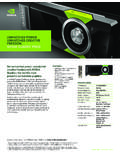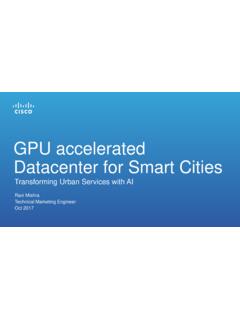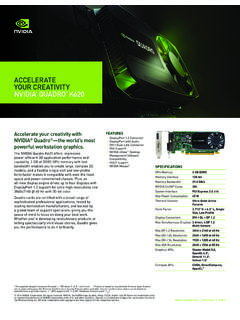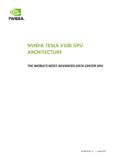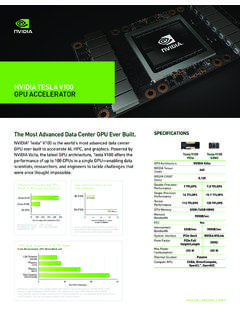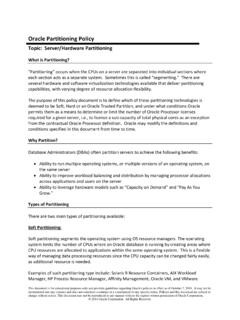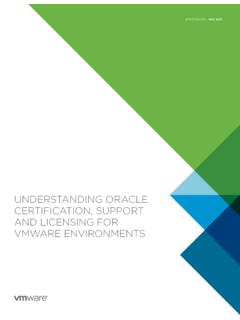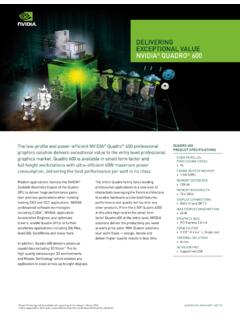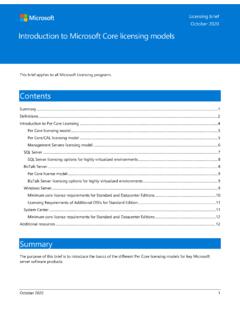Transcription of NVIDIA A100 Tensor Core GPU Architecture
1 NVIDIA A100 Tensor Core GPU Architecture UNPRECEDENTED ACCELERATION AT EVERY SCALE ii NVIDIA A100 Ten so r Co re GPU Arch itecture Table of Contents Introduction 7 Introducing NVIDIA A100 Tensor Core GPU - our 8th Generation Data Center GPU for the Age of Elastic Computing 9 NVIDIA A100 Tensor Core GPU Overview 11 Next-generation Data Center and Cloud GPU 11 Industry-leading Performance for AI, HPC, and Data Analytics 12 A100 GPU Key Features Summary 14 A100 GPU Streaming Multiprocessor (SM) 15 40 GB HBM2 and 40 MB L2 Cache 16 Multi-Instance GPU (MIG) 16 Third-Generation NVLink 16 Support for NVIDIA Magnum IO and Mellanox Interconnect Solutions 17 PCIe Gen 4 with SR-IOV 17 Improved Error and Fault Detection, Isolation, and Containment 17 Asynchronous Copy 17 Asynchronous Barrier 17 T ask Graph Acceleration 18 NVIDIA A100 Tensor Core GPU Architecture In-Depth 19 A100 SM Architecture 20 Third-Generation NVIDIA Tensor Core 23 A100 Tensor Cores Boost Throughput 24 A100 Tensor Cores Support All DL Data Types 26 A100 Tensor Cores Accelerate HPC 28 Mixed Precision Tensor Cores for HPC 28 A100 Introduces Fine-Grained Structured Sparsity 31 Sparse Matrix Definition 31 Sparse Matrix Multiply-Accumulate (MMA)
2 Operations 32 Combined L1 Data Cache and Shared Memory 33 Simultaneous Execution of FP32 and INT32 Operations 34 A100 HBM2 and L2 Cache Memory Architectures 34 iii NVIDIA A100 Ten so r Co re GPU Arch itecture A100 HBM2 DRAM Subsystem 34 ECC Memory Resiliency 35 A100 L2 Cache 35 Maximizing Tensor Core Performance and Efficiency for Deep Learning Applications 37 Strong Scaling Deep Learning Performance 38 New NVIDIA Ampere Architecture Features Improved Tensor Core Performance 38 Compute Capability 43 MIG (Multi-Instance GPU) Architecture 44 Background 44 MIG Capability of NVIDIA Ampere GPU Architecture 45 Important Use Cases for MIG 45 MIG Architecture and GPU Instances in Detail 47 Compute Instances 49 Compute Instances Enable Simultaneous Context Execution 51 MIG Migration 52 Third-Generation NVLink 52 PCIe Gen 4 with SR-IOV 53 Error and Fault Detection, Isolation.
3 And Containment 53 Additional A100 Architecture Features 54 NVJPG Decode for DL Training 54 Optical Flow Accelerator 55 Atomics Improvements 56 NVDEC for DL 56 CUDA Advances for NVIDIA Ampere Architecture GPUs 58 CUDA T ask Graph Acceleration 58 CUDA T ask Graph Basics 58 Task Graph Acceleration on NVIDIA Ampere Architecture GPUs 59 CUDA Asynchronous Copy Operation 61 Asynchronous Barriers 63 L2 Cache Residency Control 64 Cooperative Groups 66 Conclusion 68 Appendix A - NVIDIA DGX A100 69 iv NVIDIA A100 Ten so r Co re GPU Arch itecture NVIDIA DGX A100 - The Universal System for AI Infrastructure 69 Game-changing Performance 70 Unmatched Data Center Scalability 71 Fully Optimized DGX Sof tware Stack 71 NVIDIA DGX A100 System Specif ications 74 Appendix B - Sparse Neural Network Primer 76 Pruning and Sparsity 77 Fine-Grained and Coarse-Grained Sparsity 77 v NVIDIA A100 Ten so r Co re GPU Arch itecture List of Figures Figure 1.
4 Modern cloud datacenter workloads require NVIDIA GPU acceleration .. 8 Figure 2. New Technologies in NVIDIA 10 Figure 3. NVIDIA A100 GPU on new SXM4 Module .. 12 Figure 4. Unified AI Acceleration for BERT-LARGE Training and Inference .. 13 Figure 5. A100 GPU HPC application speedups compared to NVIDIA Tesla V100 .. 14 Figure 6. GA100 Full GPU with 128 SMs (A100 Tensor Core GPU has 108 SMs) .. 20 Figure 7. GA100 Streaming Multiprocessor (SM) .. 22 Figure 8. A100 vs V100 Tensor Core 25 Figure 9. TensorFloat-32 (TF 32) .. 27 Figure 10. Iterations of TCAIRS Solver to Converge to FP64 Accuracy .. 30 Figure 11. TCAIRS solver speedup over the baseline FP64 direct 30 Figure 12. A100 Fine-Grained Structured Sparsity .. 32 Figure 13. Example Dense MMA and Sparse MMA 33 Figure 14.
5 A100 Tensor Core Throughput and Efficiency .. 39 Figure 15. A100 SM Data Movement Efficiency .. 40 Figure 16. A100 L2 cache residency controls .. 41 Figure 17. A100 Compute Data Compression .. 41 Figure 18. A100 strong-scaling 42 Figure 19. Software-based MPS in Pascal vs Hardware-Accelerated MPS in 44 Figure 20. CSP Multi-user node Today .. 46 Figure 21. Example CSP MIG Conf iguration .. 47 Figure 22. Example MIG compute configuration with three GPU Instances.. 48 Figure 23. MIG Configuration with multiple independent GPU Compute workloads .. 49 Figure 24. Example MIG partitioning process .. 50 Figure 25. Example MIG config with three GPU Instances and four Compute Instances.. 51 Figure 26. NVIDIA DGX A100 with Eight A100 53 Figure 27.
6 Illustration of optical f low and stereo disparity .. 55 Figure 28. Execution Breakdown for Sequential 2us Kernels.. 59 Figure 29. Impact of Task Graph acceleration on CPU launch latency .. 60 Figure 30. Grid-to-Grid Latency Speedup using CUDA graphs .. 61 Figure 31. A100 Asynchronous Copy vs No Asynchronous Copy .. 62 Figure 32. Synchronous vs Asynchronous Copy to Shared Memory .. 63 Figure 33. A100 Asynchronous 64 Figure 34. A100 L2 residency control 66 Figure 35. Warp-Wide Reduction .. 67 Figure 36. NVIDIA DGX 100 System .. 69 Figure 37. DGX A100 Delivers unprecedented AI performance for training and inference.. 70 Figure 38. NVIDIA DGX Sof tware Stack .. 72 Figure 39. Dense Neural Network .. 76 Figure 40. Fine-Grained Sparsity.
7 78 Figure 41. Coarse Grained 79 Figure 42. Fine Grained Structured Sparsity .. 80 vi NVIDIA A100 Ten so r Co re GPU Arch itecture List of Tables Table 1. NVIDIA A100 Tensor Core GPU Performance Specs .. 15 Table 2. A100 speedup over V100 (TC= Tensor Core, GPUs at respective clock speeds) .. 23 Table 3. A100 Tensor Core Input / Output Formats and Performance vs FP32 FFMA.. 27 Table 4. Comparison of NVIDIA Data Center GPUs .. 36 Table 5. Compute Capability: GP100 vs GV100 vs GA100 .. 43 Table 6. NVJPG Decode Rate at different video 55 Table 7. GA100 HW decode support .. 56 Table 8. Decode performance @ GPU boost clock (1410 MHz) .. 56 Table 9. A100 vs V100 Decode Comparison @ 1080p30 .. 57 Table 10. NVIDIA DGX A100 System Specif ications.
8 74 Table 11. Accuracy achieved on various networks with 2:4 fine grained structured sparsity81 Introduction to the NVIDIA A100 Ten so r Co re GPU 7 NVIDIA A100 Ten so r Co re GPU Arch itecture Introduction The diversity of compute-intensive applications running in modern cloud data centers has driven the explosion of NVIDIA GPU-accelerated cloud computing. Such intensive applications include AI deep learning training and inference, data analytics, scientific computing, genomics, edge video analytics and 5G services, graphics rendering, cloud gaming, and many more. From scaling-up AI training and scientific computing, to scaling-out inference applications, to enabling real-time conversational AI, NVIDIA GPUs provide the necessary horsepower to accelerate numerous complex and unpredictable workloads running in today s cloud data centers.
9 NVIDIA GPUs are the leading computational engines powering the AI revolution, providing tremendous speedups for AI training and inference workloads. In addition, NVIDIA GPUs accelerate many types of HPC and data analytics applications and systems, allowing customers to effectively analyze, visualize, and turn data into insights. NVIDIA s accelerated computing platforms are central to many of the world s most important and fastest-growing industries. HPC has grown beyond supercomputers running computationally-intensive applications such as weather forecasting, oil & gas exploration, and financial modeling. Today, millions of NVIDIA GPUs are accelerating many types of HPC applications running in cloud data centers, servers, systems at the edge, and even deskside workstations, servicing hundreds of industries and scientific domains.
10 AI networks continue to grow in size, complexity, and diversity, and the usage of AI-based applications and services is rapidly expanding. NVIDIA GPUs accelerate numerous AI systems and applications including: deep learning recommendation systems, autonomous machines (self-driving cars, factory robots, etc.), natural language processing (conversational AI, real-time language translation, etc.), smart city video analytics, software-defined 5G networks (that can deliver AI-based services at the Edge), molecular simulations, drone control, medical image analysis, and more. Introduction to the NVIDIA A100 Ten so r Co re GPU 8 NVIDIA A100 Ten so r Co re GPU Arch itecture Diverse and computationally-intensive workloads in modern cloud data centers require NVIDIA GPU acceleration Figure 1.
